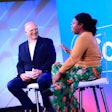[This article originally appeared in the April/May 2006 issue of BizBash magazine.]
When Preston Robert Tisch, chairman of the board of Loews Corporation, passed away last year, his family recognized that his death needed to be publicly acknowledged. So two executives from the company—Candace Leeds and Jeffrey Stewart—worked with the family to plan his memorial service, which was held December 9, 2005, at Avery Fisher Hall at Lincoln Center.
For Leeds, Loews’ vice president of public affairs, this wasn’t the first time helping out on such an occasion. “I have been involved with memorial situations large and small,” she says, for colleagues at past and present jobs.
In other words, corporate event pros often find themselves using their skills to plan a funeral instead of a fete, or to write an obituary instead of a press release. And memorials have specific needs. “This is all virgin territory—this is all a new experience for a lot of people,” says Barbara Jo Saler, a planner in Wynnewood, Pennsylvania, who helped plan the memorial for Willard G. Rouse III, the founder of Liberty Property Trust, who passed away in 2003.
Though burial services are usually attended only by family and close friends, companies have increasingly partaken in memorial ceremonies, especially if the service is for a business leader or a prominent person in the community. “There’s a big difference between doing a memorial attached to a funeral, as opposed to doing a memorial weeks or months afterwards,” says Saler. “I think most are done like the Peter Jennings service.”
The esteemed ABC News anchorman, who died of lung cancer on August 7, 2005, was buried by his family in a private service. But the public and his former colleagues had a chance to remember him on September 20 at Carnegie Hall. Free tickets were available to the general public on a first-come, first-served basis, and an assortment of notable guests—Katie Couric, Larry King, Diane Sawyer—attended. An opening of bagpipe music was followed by speeches interspersed with music by the likes of Wynton Marsalis, nodding to Jennings’ love of jazz.
In this case, spacing the public memorial a good length of time from the burial allowed people to come to terms with a sudden death. In addition to the timing, start by considering the service’s function. “I think it’s important to tell the whole story of that person’s life,” says Karen Holt Homer, an independent producer based in Malvern, Pennsylvania, who has worked on memorial services. “Bring in an unknown aspect of that person’s life to the audience. ... You may not know that person made meals every Saturday at a shelter. You can tell a broader story of who the person was.”
When Saler planned the service for Rouse, she met first with his family to decide what the ceremony should comprise. After that, she and the event’s team left the family alone to grieve. They met with the directors of the Kimmel Center, a performing arts space in Philadelphia that Rouse championed. The noontime program included a gospel choir, performers from the Philadelphia Orchestra, and a video about Rouse’s life. “It was done specifically in the middle of the day,” says Saler, “so people could take off work over lunch [to attend].”
About 1,500 people showed up, which brings up another challenge: While most events start with a predetermined number of guests, with a public memorial, Saler says, “You don’t know how many people are coming.” While a church, synagogue, or funeral home might work with a smaller group, for a larger crowd, a concert hall or auditorium might be more appropriate.
Remember that you may need an overflow area if too many people show up. Or, in the case of a company with employees in multiple locations, a service could be broadcast via the Web. Kenneth J. Popillo, a licensed funeral director at Carmon Community Funeral Homes, in Windsor, Connecticut, says his company has started offering this service to corporate clients. He’s also made arrangements for shuttle buses to bring co-workers to a service to alleviate parking problems.
The larger the memorial, the more care needs to be taken so that size doesn’t overwhelm the solemnity of the occasion. “If it’s a giant event, you need to approach it almost like planning a regular event in general PR,” says Leeds, noting how outside agencies and PR firms might help out the internal event and communications department.
Timing is crucial with larger services. Traditional memorial services last a few hours and are timed for the afternoon and evening. For a grander ceremony celebrating a public figure, however, a lunch hour or a Saturday would be appropriate, so people can attend without missing work. The service itself should last about an hour. “You don’t want it to be too long, otherwise it’s too taxing on everybody,” says Saler.
She creates a timeline of the event, which often includes speakers eulogizing the deceased, musical performances, and perhaps a slideshow of the person’s life and achievements. She also works with speakers, giving them a suggested amount of time to share their thoughts. Some time could be set aside in a program for unplanned speakers to share a few words, although depending on the scale of the service, this may not be appropriate or fit into the timeline.
The speakers themselves should be chosen from a broad spectrum of the deceased person’s life. Anthony M. LiCausi, the funeral director at the Robertaccio Funeral Home in Patchogue, New York, was asked by numerous corporate clients to have company representatives speak at services for employees who died in the September 11, 2001, terrorist attacks.
“Identify the areas this individual has touched, and have a representative or speaker from those areas,” says Homer, who helped plan a memorial for Walter Annenberg, the media executive, publisher, and diplomat.
Music should be carefully selected as well. “I think live music is nice,” says Leeds. “Something that had meaning to the deceased.” At the January memorial service at Carnegie Hall for Kal Ruttenstein, the senior vice president of Bloomingdale’s who died in December 2005, the Princeton Footnotes, a male a cappella ensemble, sang the school’s alma mater song, and—because Ruttenstein was a Broadway fan—Daphne Ruben-Vega from the original cast of Rent performed a song from the show.
Those kinds of personal touches ensure the memorial represents the person and comforts attendees. Should there be a moment of silence? A prayer? The deceased person’s family and life should dictate the protocol. “It’s such a personal thing, an individual thing,” says Saler. “It has to have a lot of sensitivity...and creativity.”
Family Matters
Before you start planning, always connect with the deceased person’s family. “A funeral and memorial are very, very personal,” says Loews Corporation vice president of public affairs Candace Leeds. “It has to really come from the family, as far as how to go about things. The key is to do something in keeping with the person and desires of the family. If the person was very modest and low-key, make sure the service reflects that.”
Hiring a funeral director or an event planner with funeral experience can be especially helpful if that person can act as a liaison to the family, to communicate with them to determine their wishes, and perhaps even get ideas or materials that can contribute to the memorial.
And the family should feel welcome to participate, too. At the memorial for Willard G. Rouse III, the founder and chairman of the board of Liberty Property Trust who passed away in 2003, his children made brief speeches about their father. “We did a rehearsal right before the service,” says Barbara Jo Saler, who helped plan the service. “We let the family come onto the stage, the children who were speaking, so they had the experience beforehand.” Special considerations were also made for the family with comfort food served for them in a private area at the venue with comfortable chairs, small tables, and plants.
More in Strategy
Most Popular



















